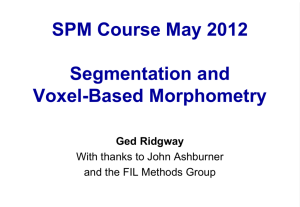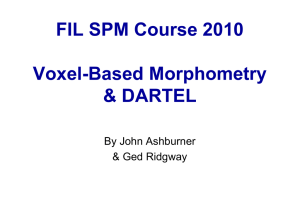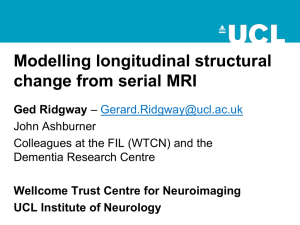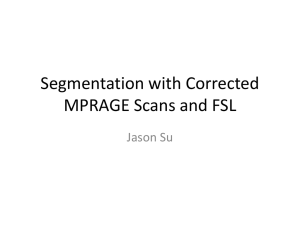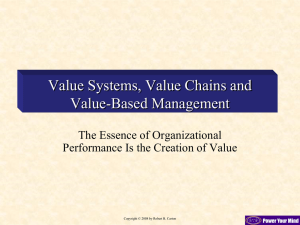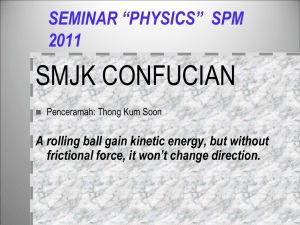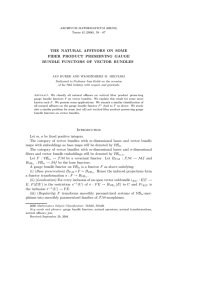Voxel-based morphometry - Translational Neuromodeling Unit
advertisement
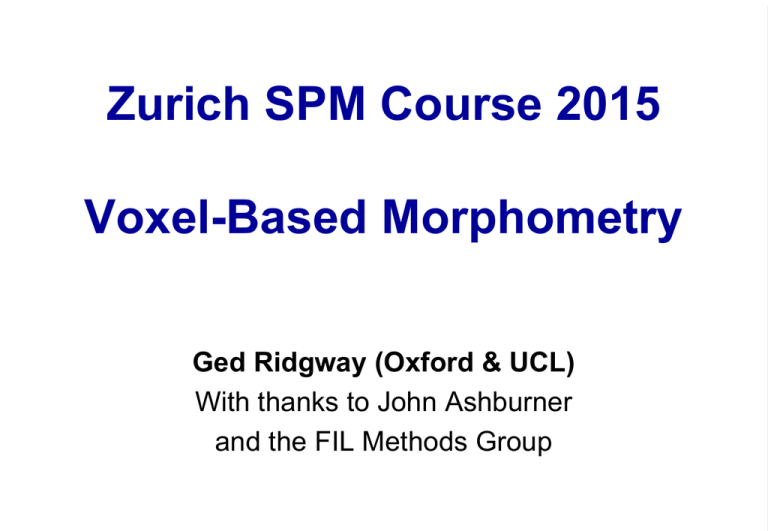
Zurich SPM Course 2015 Voxel-Based Morphometry Ged Ridgway (Oxford & UCL) With thanks to John Ashburner and the FIL Methods Group Examples applications of VBM • Many scientifically or clinically interesting questions • might relate to the local volume of regions of the brain For example, whether (and where) local patterns of brain morphometry help to: − − − − Distinguish groups (e.g. schizophrenics and healthy controls) Explain the changes seen in development and aging Understand plasticity, e.g. when learning new skills Find structural correlates (scores, traits, genetics, etc.) VBM and political orientation • R. Kanai, T. Feilden, C. Firth, G. Rees • Political Orientations Are Correlated with Brain Structure in Young Adults. DOI:10.1016/j.cub.2011.03.017 Overview of SPM Statistical parametric map (SPM) Image time-series Realignment Kernel Smoothing Design matrix General linear model Statistical inference Normalisation Gaussian field theory p <0.05 Template Parameter estimates Tissue segmentation for VBM • High-resolution MRI reveals fine structural detail in the brain, but not all of it reliable or interesting − Noise, intensity-inhomogeneity, vasculature, … • MR Intensity is usually not quantitatively meaningful (in the same way that e.g. CT is) − − fMRI time-series allow signal changes to be analysed Quantitative MRI is possible though, and promising, see e.g. Draganski et al. (2011) PMID:21277375 • Regional volumes of the three main tissue types: gray matter, white matter and CSF, are well-defined and potentially very interesting Tissue segmentation in SPM12 vs SPM8 • SPM8 had a “New Segment” toolbox in addition to the • • main segmentation button SPM8’s main segmentation has become the “Old Segment” toolbox in SPM12 SPM8’s New Segment provided the basis for SPM12’s segmentation, but there are several changes… − − − New TPM.nii (from multispectral IXI database) Allowing rescaling of TPMs (like in Old Segment!) For full detail see SPM12 Release Notes and Appendix A in Malone et al. (2015) [PMID:25255942] Tissue segmentation in SPM12 vs SPM8 • Evaluation of SPM12 versus SPM8 (Old) in terms of total intracranial volume, compared to manual tracing Voxel-Based Morphometry • In essence VBM is Statistical Parametric Mapping of regional segmented tissue density or volume • The exact interpretation of gray matter density or volume is complicated, and depends on the preprocessing steps used − It is not interpretable as neuronal packing density or other cytoarchitectonic tissue properties − The hope is that changes in these microscopic properties may lead to macro- or mesoscopic VBM-detectable differences VBM overview • Unified segmentation and spatial normalisation − More flexible groupwise normalisation using DARTEL • Modulation to preserve tissue volume − − Otherwise, tissue “density” (harder to interpret) See also Radua et al. (2014) [PMID:23933042] • Optional computation of tissue totals/globals • Gaussian smoothing • Voxel-wise statistical analysis VBM in pictures Segment Normalise VBM in pictures Segment Normalise Modulate Smooth VBM in pictures Segment Normalise Modulate Smooth Voxel-wise statistics a1xyz a 2 xyz Y X xyz exyz 2 aNxyz exyz ~ N (0, xyz V) 1 1 X 0 0 0 0 1 1 VBM in pictures beta_0001 con_0001 ResMS spmT_0001 Segment Normalise Modulate Smooth Voxel-wise statistics FWE < 0.05 VBM Subtleties • • • • • Modulation How much to smooth Interpreting results Adjusting for total GM or Intracranial Volume Statistical validity Native Modulation (“preserve amounts”) 1 intensity = tissue probability 1 • Multiplication of warped (normalised) tissue intensities so that their regional total is preserved o Can detect differences in completely registered areas Unmodulated 1 1 1 1 • Otherwise, we preserve concentrations, and are detecting mesoscopic effects that remain after approximate registration has removed the macroscopic effects o Flexible (not necessarily “perfect”) warping leaves less See also http://tinyurl.com/ModulationTutorial Modulated 2/3 1/3 1/3 2/3 Modulation (“preserve amounts”) • Top shows “unmodulated” data (wc1), with intensity or concentration preserved − Intensities are constant • Below is “modulated” data (mwc1) with amounts or totals preserved − The voxel at the cross-hairs brightens as more tissue is compressed at this point Smoothing • The analysis will be most sensitive to effects that match • the shape and size of the kernel The data will be more Gaussian and closer to a continuous random field for larger kernels − Usually recommend >= 6mm • Results will be rough and noise-like if too little • smoothing is used Too much will lead to distributed, indistinct blobs − Usually recommend <= 12mm Smoothing • The results below show two fairly extreme choices − 5mm on the left, and 16mm on the right Smoothing as a locally weighted ROI • VBM > ROI: no subjective (or arbitrary) boundaries • VBM < ROI: harder to interpret blobs & characterise error Interpreting findings Thinning Mis-register Mis-classify Mis-register Thickening Folding Contrast Interpreting findings VBM is sometimes described as “unbiased whole brain volumetry” Regional variation in registration accuracy Segmentation problems, issues with analysis mask Intensity, folding, etc. But significant blobs probably still indicate meaningful systematic effects! Adjustment for “nuisance” variables • Anything which might explain some variability in regional volumes of interest should be considered − − Age and gender are obvious and commonly used • Consider age+age2 to allow quadratic effects Site or scanner if more than one (Note: model as factor, not covariate; multiple binary columns) • Total grey matter volume often used for VBM − − Changes interpretation when correlated with local volumes (shape is a multivariate concept… See next slide) Total intracranial volume (TIV/ICV) sometimes more powerful and/or more easily interpretable, see also Barnes et al. (2010); Malone et al. (2015) Adjustment for total/global volume • Shape is really a multivariate concept o Dependencies among volumes in different regions • SPM is mass univariate o o Combining voxel-wise information with “global” integrated tissue volume provides a compromise Using either ANCOVA or proportional scaling (ii) is globally thicker, but locally thinner than (i) – either of these effects may be of interest to us. Fig. from: Voxel-based morphometry of the human brain… Mechelli, Price, Friston and Ashburner. Current Medical Imaging Reviews 1(2), 2005. VBM’s statistical validity • Residuals are not normally distributed − Little impact for comparing reasonably sized groups − Potentially problematic for comparing single subjects or tiny patient groups with a larger control group • (Scarpazza et al, 2013; DOI: 10.1016/j.neuroimage.2012.12.045) − Mitigate with large amounts of smoothing − Or use nonparametric tests, e.g. permutation testing (SnPM) • Though also not suitable for single case versus control group… • Smoothness is not spatially stationary − − Bigger blobs expected by chance in smoother regions NS toolbox http://www.fil.ion.ucl.ac.uk/spm/ext/#NS • Voxel-wise FDR is common, but not recommended Spatial normalisation with DARTEL • VBM is crucially dependent on registration performance − − − − The limited flexibility of DCT normalisation has been criticised Inverse transformations are useful, but not always well-defined More flexible registration requires careful modelling and regularisation (prior belief about reasonable warping) MNI/ICBM templates/priors are not universally representative • The DARTEL toolbox combines several methodological advances to address these limitations − Voxel-wise DF, integrated flows, group-wise registration of GM & WM tissue segments to their (iteratively evolving) average DARTEL average template evolution Template 1 Rigid average (Template_0) Average of mwc1 using segment/DCT Template 6 Part of Fig.1 in Klein et al. Part of Fig.5 in Klein et al. Summary • VBM performs voxel-wise statistical analysis on • smoothed (modulated) normalised tissue segments SPM performs segmentation and spatial normalisation in a unified generative model − Based on Gaussian mixture modelling, with warped spatial prior probability maps, and multiplicative bias field • Subsequent (non-unified) use of DARTEL improves spatial normalisation for VBM − (and probably also fMRI...) Longitudinal VBM – motivation • Development, growth, plasticity, aging, degeneration, • • and treatment-response are inherently longitudinal Serial data have major advantages over multiple crosssectional samples at different stages Increasing power − Subtlety of change over time vs. inter-individual variation • Reducing confounds − − Separating within-subject changes from cohort effects Demonstrating causality with interventions Longitudinal VBM – preprocessing • Intra-subject registration over time is much more accurate than inter-subject normalisation • Simple approach: rigid realignment within-subject − Apply one spatial normalisation to all timepoints − E.g. Draganski et al (2004) Nature 427: 311-312 • More sophisticated approaches use nonlinear within-subject registration − Information transferred to volume-change maps Longitudinal VBM – asymmetry & bias • Within-subject image processing often treats one timepoint differently from the others − − Later scans registered (rigidly or non-rigidly) to baseline Baseline scan segmented (manually or automatically) • Asymmetry can introduce methodological biases − − − E.g. only baseline has no registration interpolation error Baseline seg. more accurate than propagated segs. Change in later intervals more regularised/constrained Longitudinal VBM – registration in SPM12 • Ashburner & Ridgway (2013) [PMID: 23386806] • “Unified” rigid and non-rigid registration with model of • • • • differential intensity inhomogeneity (bias) “Generative” – each time-point is a reoriented, spatially warped, intensity biased version of avg. “Symmetric” with respect to permutation of images “Consistent” with direct registration between pair “Diffeomorphic” – complex warping without folding Longitudinal VBM – registration in SPM12 Longitudinal VBM – modelling • The longitudinal registration produces a within-subject average and maps of volume change relative to it − − − Can perform cross-sectional VBM (Dartel, etc.) on averages Same spatial normalisation for volume-change maps Can multiply volume change with GM, then smooth • Simplest longitudinal statistical analysis: two-stage summary statistic approach (like in fMRI) − − Contrast on the slope parameter for a linear regression against time within each subject (usual group analyses of con images) For two time-points with interval approximately constant over subjects, equivalent to simple time2 – time1 difference image Longitudinal VBM – Getting started… • No longitudinal examples in SPM manual yet… − − Support on SPM list http://www.fil.ion.ucl.ac.uk/spm/support/ Or email me: ged.ridgway@gmail.com • The following slides illustrate usage of the longitudinal registration toolbox in the batch interface in SPM12 No Longitudinal button, but found in Batch menu, like Dartel, etc. Choice of paired or general serial. No difference in model, but easier specification and results for pairs. Specify Time 1 scans for all subjects, then all Time 2 scans (in same order!) Vector (list) of time intervals (yr) Default values can be left; NaN to automatically estimate (Rician) noise One module per subject (scripting required if many subjects!) Select all scans for this subject Vector (list) of times relative to arbitrary datum (e.g. baseline=0) Jacobian output useful to quantify interpretable ROI volumes (in litres) • Output/results Average image o Jacobians or divergences o Deformations o • Next steps o o o o o Segment avg Run Dartel/Shoot Warp e.g. dv to standard space SPM stats on dv (TBM) Or combine with seg of avg (VBM)

